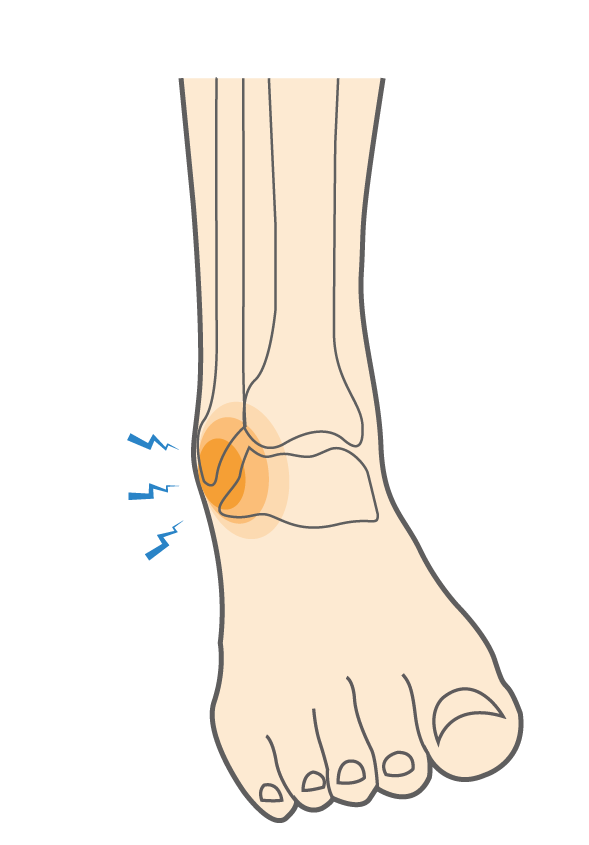Ligaments are strong bands of fibrous tissue that connect bone to bone and often play an important stabilizing role in a joint. Most sprained ankles happen when the outer, or lateral, ligaments are stretched too much. Sprains are graded based on their severity, ranging from a strain (mild) to a partial tear (moderate) to a complete tear (severe). Lateral ankle sprains can damage the ankle joint and limit your mobility. Without treatment, recurrent sprains can occur, causing chronic problems with the ankle, especially ankle swelling and pain.
Ankle Sprain (Lateral) Causes, Symptoms & Treatment Options
Ligaments are strong bands of fibrous tissue that connect bone to bone and often play an important stabilizing role in a joint. Most sprained ankles happen when the outer, or lateral, ligaments are stretched too much. Sprains are graded based on their severity, ranging from a strain (mild) to a partial tear (moderate) to a complete tear (severe).
Overview
Overview

What causes Ankle Sprain (Lateral)?
A lateral ligament injury can happen to anyone. This injury is usually caused by a sudden twisting, turning, or rolling of the ankle to one side. A twisted ankle while walking or stepping on uneven ground is a frequent cause of ankle sprain (lateral) injuries. Sprains often happen during athletic play, particularly in sports that require quick changes of direction and jumping.
Lateral ankle sprains are most common in these sports:
- Soccer
- Tennis
- Football
- Trail running
- Basketball
- Volleyball
Symptoms
Symptoms associated with lateral ligament injury will depend on the damage to the ligaments in your ankle. With a mild (first-degree) strain, you may feel mild tenderness. A moderate (second-degree) strain may result in ankle swelling and bruising. A severe (third-degree) strain is a full outer ankle ligament tear that makes it painful and difficult to walk.
Common symptoms also include:
- Pain in the lateral ankle at the onset of injury
- Swelling
- Bruising
- Tenderness
- Instability of the ankle, especially when walking on uneven surfaces
When to see a doctor
Minor ankle sprains can be treated at home with rest, ice, and elevation. However, if your twisted ankle becomes swollen and difficult to walk on, you should consult with your doctor. During your visit, your doctor will ask questions about your injury, its symptoms, and the sports you play. During the physical examination, your doctor will press your ankle to see which ligaments have been damaged. Your doctor may also want to conduct an “ankle drawer test,” which involves moving your ankle in different positions to assess your range of motion. An X-ray may be ordered to check for broken bones. Other imaging tests, such as a magnetic resonance imaging (MRI) test, may be taken to determine the extent of damage to your ligaments or to see if there are other injuries.
Non-operative treatment
The majority of ankle sprain (lateral) injuries, even severe ones, are treated without surgery. Treatment usually involves rest and keeping weight off your ankle. Conservative treatments also include:
- Ice
- Elevation
- Compression with an Ace bandage for stability
- Nonsteroidal anti-inflammatory drugs (NSAIDs), such as ibuprofen and naproxen, are used to relieve pain
- Crutches
- Wearing a special ankle brace or cast to support your ankle and protect it from re-injury
- Physical therapy exercises
Try these exercises to help address your condition:
Below is a PDF of the Exercise Program
Surgical Treatment
Surgical Treatment of a Lateral Ankle Sprain
Surgery is not common for treating ankle sprain (lateral) injuries, but may be recommended for severe cases that result in instability of the ankle, or cases that do not improve with conservative treatment. In some cases, your doctor may recommend surgery to remove bone fragments or scar tissue. In cases of recurrent twisted ankle injuries, other types of surgical procedures may be needed to repair or reconstruct chronically damaged ligaments.
Recovery
Recovery time for a lateral ligament injury will vary, depending on the severity of the sprain. However, even mild sprains can take several weeks for a full recovery. Athletes should work with their doctor and physical therapist on a rehabilitation program to facilitate their return to play. Often, athletes return to play with a brace or tape to protect their ankle from further injury.
GET BACK TO WHAT YOU LOVE. FASTER
Frequently Asked Questions
Can a lateral ligament injury heal without surgery?
Yes, most lateral ligament injuries can heal with non-surgical treatments such as rest, physical therapy, bracing, and gradual return to activity. However, severe or recurrent injuries might require surgical intervention.
How can I prevent future ankle sprains after a lateral ligament injury?
Strengthening exercises, balance training, wearing supportive footwear, and possibly using an ankle brace during high-risk activities can help reduce the risk of re-injury.
When should I seek a second opinion for a twisted ankle injury?
If symptoms like persistent pain, ankle swelling, or trouble walking don't improve after a few weeks of conservative care, it's advisable to seek a second opinion. If your ankle remains painful, you may have some additional injury to the ankle besides the lateral ligament tear.
What is the risk of delaying treatment for a lateral ligament injury?
Delaying proper care for a lateral ligament injury increases the risk of long-term instability, repeated twisted ankle injuries, chronic pain, and difficulty returning to physical activity.

